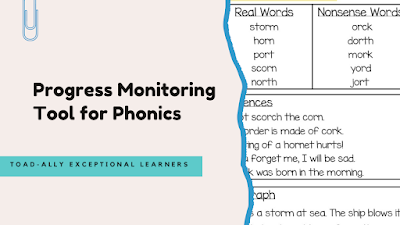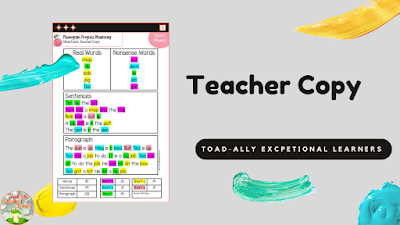Feeling unsure about a student's phonics level? This new resource will instantly help
Have you ever sat in a meeting reviewing phonics data and someone asks if the student has mastered reading digraphs because the student doesn't demonstrate this in their small group?
Whether in an RTI meeting or just reviewing the data, this information helps plan the student's specific next steps.
If your phonics program is like mine--it didn't come with a quick way to progress monitor a student after you have taught a sound (phonogram). And sometimes you need more than dictation and how they read in the last decodable text.
You need more than a gut check BUT you need a number to prove what the student knows.
This Progress Monitoring Tools for Phonics solves this problem. It's quick and super easy to give after you have taught a sound. You can learn if students can read the phonogram at the word level (real & nonsense), sentence level, or in a paragraph with controlled text.
I use this Phonics Tool as a pre/post with mixed sounds. This has a very specific set of sounds such as all short, all R-controlled or all digraphs. Then I can teach the sounds in the pattern, reassess and have the data to prove if they have it or not.
The teacher's copy of the tool is colored-coded to make it super easy to score and make decisions about what to do next. This progress monitoring tool can be completed by teachers, para-professionals, or volunteers.
Each phonogram has its own page and you can find it again on a mixed pattern page. I have made the Phonics Progress Monitoring Tool paperless as well. It can be used with Google. The link is within the product.These sheets can be completed are perfect for small targeted groups and are a perfect addition to any Orton-Gillingham Practice or Phonics Intervention.
You can expect updates throughout the year including Vowel teams, Suffixes, -ng & -nk, and more!!
Grab your today before the price increases!
Chat Soon,
POW: Readers Needing More Support--Adapted Books with High Frequency Words
How do I get my readers more exposure to high-frequency or Red Words???
ADAPTED BOOKS
I love adapted books. My students LOVE them too! They are one of my favorite tools in my classroom. When it comes to building language skills or more experience with text--adapted books are a great way to effectively target specific skills in a way that is engaging for students.
What is an Adapted Book?
Adapted books are books that have been modified in some way and often make it easier for students with disabilities to use but I also find adapted books are more engaging for all students to read and target so many critical language skills. I create and use adapted books all the time because they are interactive, motivating, and target various language skills. Many allow the students to feel successful and part of the book because they have to add or move pieces within the book.
Why You Need Adapted Books?
Research tells us kids with severe and profound disabilities often get sub-par literacy instruction. Part of that is based on people’s assumptions about the abilities of students with complex disabilities, the idea that instructional materials should only focus on functional or sight word instruction, and fact that language skills are generally lacking for students in this population. The other part of that is a feeling that instructional materials are just not made for these students in a way that is accessible.
There are a couple of big targets you are trying to hit when you add adapted books or novels to your classroom and lessons. One of them is to increase a student’s access to literature. You would be amazed at how many classrooms have NO appropriate reading materials in their classrooms. Because our students take longer to learn new skills, available literature tends to be juvenile or fully functional.
It is imperative students with severe disabilities are exposed to developed ideas and advanced concepts as a means of improving overall literacy and adapted books are the perfect vehicle to do that.
Adapted books can vary in skill level and be used for a wide variety of students with different skill sets and literacy skills. Many times there are pictures associated with the vocabulary terms so it provides those extra visual supports to help with understanding and comprehension of the verbal message. As the books become more challenging students rely less on pictures and more on written words.
What is a High-Frequency Adapted Book?
Predictable texts are a specific type of book used in the earliest stages of reading instruction. It provides students with more frequent exposure to the targeted word. The texts have a repeated sentence or phrase on each page, typically with one variable word. A picture accompanies each sentence that allows the student to guess the variable word using the picture.
Errorless teaching is an instructional strategy that ensures children always respond correctly. Each page has only one answer--the target word. This means students are getting more frequent correct exposure to the word than reading authentic text where they can guess at the word.
Why Have Visuals Tied to Text?
Visuals are consistent. Visuals allow time for language processing. Visual prompts can offer a visual image and written word to meet the needs of a variety of students’ abilities. Visuals help students see what a word means. Visuals help to build independence.
So What Should I Do?
The first thing you should do is get this FREE adapted book by clicking here! Yeah. I love my readers… a lot. This is a very simple book.
Are you wanting more???? This bundle has 7 more to help you build your student's high-frequency reading knowledge.
Chat Soon-
PS--Bundle 2 coming soon
3 Fan Favoriate Phonemic Awareness Ideas (that are free)
What is Phonemic Awareness?
Phonemic Awareness (PA) is:
- the ability to hear and manipulate the sounds in spoken words and the understanding that spoken words and syllables are made up of sequences of speech sounds
- essential to learning to read in an alphabetic writing system, because letters represent sounds or phonemes. Without phonemic awareness, phonics makes little sense
- fundamental to mapping speech to print. If a child cannot hear that "man" and "moon" begin with the same sound or cannot blend the sounds /rrrrrruuuuuunnnnn/ into the word "run", he or she may have great difficulty connecting sounds with their written symbols or blending sounds to make a word
- essential to learning to read in an alphabetic writing system
- a strong predictor of children who experience early reading success
Why is it important?
- It requires readers to notice how letters represent sounds. It primes readers for print
- It gives readers a way to approach sounding out and reading new words
- It helps readers understand the alphabetic principle (that the letters in words are systematically represented by sounds)
...but difficult:
- Although there are 26 letters in the English language, there are approximately 40 phonemes, or sound units, in the English language
- Sounds are represented in 250 different spellings (e.g., /f/ as in ph, f, gh, ff)
- The sound units (phonemes) are not inherently obvious and must be taught. The sounds that make up words are "coarticulated;" that is, they are not distinctly separate from each other
What Does the Lack of Phonemic Awareness Look Like?
Children lacking phonemic awareness skills cannot:
- group words with similar and dissimilar sounds (mat, mug, sun)
- blend and split syllables (f oot)
- blend sounds into words (m_a_n)
- segment a word as a sequence of sounds (e.g., fish is made up of three phonemes, /f/ , /i/, /sh/)
- detect and manipulate sounds within words (change r in run to s)
Evidence Based Practices and the Big 5
Evidence-based practices in education are the same. They are backed by rigorous, high-standard research, replicated with positive outcomes, and backed by their effects on student outcomes. EBPs take the guesswork out of teaching by providing specific approaches and programs that improve student performance. There is frustration in teaching when you cannot find a way to help your student learn. You try one thing and then another and another and they are not having positive outcomes for your student. EBPs have proven outcomes on students’ performance and can make finding and implementing an effective practice less frustrating.
Using evidence-based practices (EBPs), with special education students especially, is a critical feature of improving their learning outcomes. When teachers combine their expertise as content knowledge experts with explicit instruction and practices and programs backed by research, the likelihood that a child will grow academically is increased.
A quick history lesson
We all love or hate the Big 5.
BUT..... without them
Congress appointed a National Reading Panel (NPR) in 1997 to review reading research and determine the most effective methods for teaching reading. The NRP reviewed over 100,000 studies and analyzed them to see what techniques actually worked in teaching children to read. The group only looked at quantitative studies, which gathered data in a numerical form and through structured techniques. Qualitative studies, which gather data through observations such as interviews were not included. In 2000 the NRP submitted their final report. The results became the basis of the federal literacy policy at that time, which included “No Child Left Behind.” We still base our understanding of evidence-based reading research on the NPR, but sadly, some of their major recommendations have been largely ignored. So what were their findings? They concluded that there were five essential components to reading, known as “The Big Five:”
- Explicit instruction in Phonemic Awareness.
- Systematic Phonics Instruction.
- Techniques to improve Fluency. These include guided oral reading practices where the student reads aloud and the teacher makes corrections when the student mispronounces a word. A teacher can also model fluent reading to the student. Fluency includes accuracy, speed, understanding, and prosody. Word calling is not the same as fluency.
- Teaching vocabulary words or Vocabulary Development.
- Reading Comprehension.
On top of this comes systematic Phonics. Children learn that the sounds in spoken words relate to the patterns of letters in written words. Not just mastery of the skills of systematic phonics, but automaticity in those skills, is also necessary for fluency to develop.
With these two layers in place and developed to the point of automaticity, techniques to improve Fluency can begin to be effective.
Vocabulary Development can be built next, including learning the meaning of new words through direct and indirect instruction, and developing tools like morphemic analysis, to discover the meaning of an unknown word.
Then Comprehension Skills can be added. Comprehension skills are the strategies a reader can use to better comprehend a text.
This is the foundation of reading, but it is also the foundation of education generally. Every subject is dependent on reading, and mastery of these subjects depends on developing a strong foundation in these early literacy skills.
As I continue to explore Evidenced-Based Practices, I will use the “Big 5” to share how they can be developed, and provide some resources that you can take back and use.
Chat Soon,

About Me
Resource Library
Thank you! You have successfully subscribed to our newsletter.



















